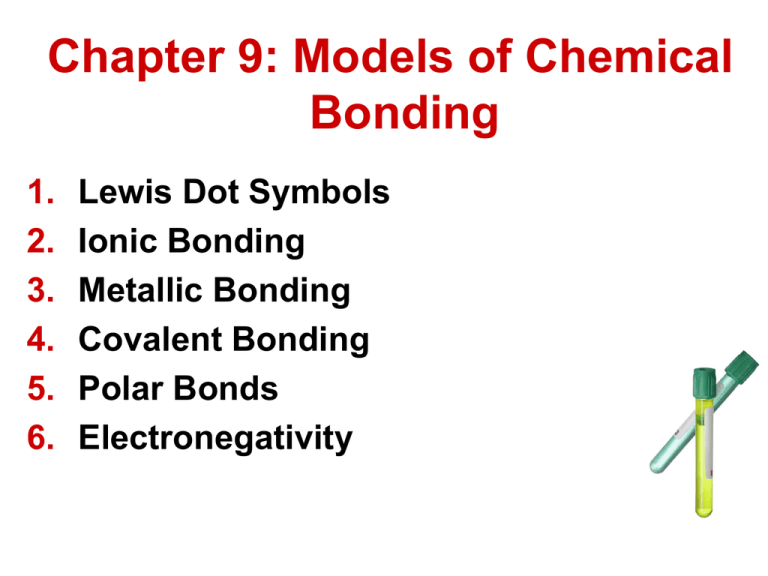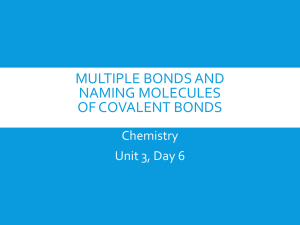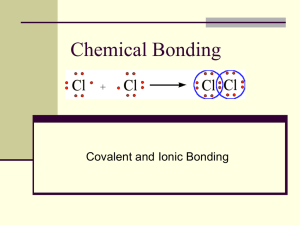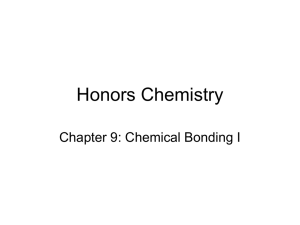Chapter 8 Basic Concepts of Chemical Bonding_student version
advertisement

Chapter 9: Models of Chemical Bonding 1. 2. 3. 4. 5. 6. Lewis Dot Symbols Ionic Bonding Metallic Bonding Covalent Bonding Polar Bonds Electronegativity • Lewis symbols Examples: Na and : C : Practice • Give Lewis dot symbols for: magnesium Oxide ion nitrogen Sodium ion fluorine argon boron Types of Bonding and Properties Ionic Metallic Covalent Ionic Bonding • Ionic compounds form • The attraction • Forming ions takes energy Metallic Bonding • Outer electrons • Large numbers of metal atoms • The electrons are ‘delocalized’ Covalent Bonds Network Covalent Solids http://www.hull.ac.uk/chemistry/intro_inorganic/images/diamond.jpg Polar Covalent Bonds • When two identical atoms form a covalent bond • When different kinds of atoms combine, (a) (b) • Electronegativity • In general, electronegativity increases http://www.chem.ufl.edu/~itl/2045/change/C9F16.GIF • The difference in electronegativity • There is no sharp dividing line between ionic and covalent bonding: • A bond is mostly ionic when • The degree of polarity, or ionic character, varies continuously with the electronegativity difference Each atom in a bond has a partial charge of about +0.5 or –0.5 units when the electronegativity difference is 1.7. Electronegativity diff. Type of bonding >1.7 Mostly ionic 0.4-1.7 Polar covalent <0.4 Mostly covalent 0 Nonpolar covalent Practice Questions • A. B. C. D. Identify the following bonds as Mostly ionic Polar Covalent Mostly Covalent Nonpolar Covalent C-Cl Re-H Li-Cl P-H Sn-Br Sr-O • Lewis symbols can be used to represent the covalent or electron pair bond HHH:H Formulas drawn with Lewis symbols are called Lewis formulas or Lewis structures • The term structural formula • Many molecules obey the octet rule: • The number of bonds an atom (second-row) forms is determined by: Number of Bonds C N O F B Has 4 e- Needs 4 e- Forms 4 bonds • single bond • Double and triple bonds • The bond order • • • • A single bond has bond order of a double bond a bond order of a triple bond a bond order of Bond length depends on bond order: Drawing Lewis Structures • • • The least electronegative atom is usually in the middle. (Or the atom which can form the most bonds.) Count total number of valence electrons in molecule/ion. Place them around the atoms to satisfy the octet rule: Phosphorus Trichloride Carbon Dioxide • Not all structures obey the octet rule Sulfur tetrafluoride Bromine pentafluoride • The preferred Lewis structure is the one that best fits the experimental data The structure of sulfuric acid in the vapor state. There are two different sulfur-oxygen bond lengths. The preferred Lewis structure needs different bond orders for these atoms. :O: | :O: || HO S O H HO S O H :O : :O: StructureI StructureII | • Structure I • Structure II || • formal charge • The formal charge on an atom is calculated • Consider the sulfur atoms in the two structures for sulfuric acid: :O: | :O: || HO S O H HO S O H :O : :O: | || StructureI StructureII Structure I: formal charge on S = Structure II: formal charge on S = When several Lewis structures are possible, Nitrate ion Iodate ion Formal charge on O = Formal charge on I = Formal charge on O = Formal charge on I = • Some molecules and ions are not well represented by a single Lewis structure • Consider the case of the formate ion, HCO2- Experiment gives These are called resonance structures Draw the resonance forms for nitrate. Draw resonance forms for thiosulfate. Draw the resonance forms for dinitrogen monoxide.









